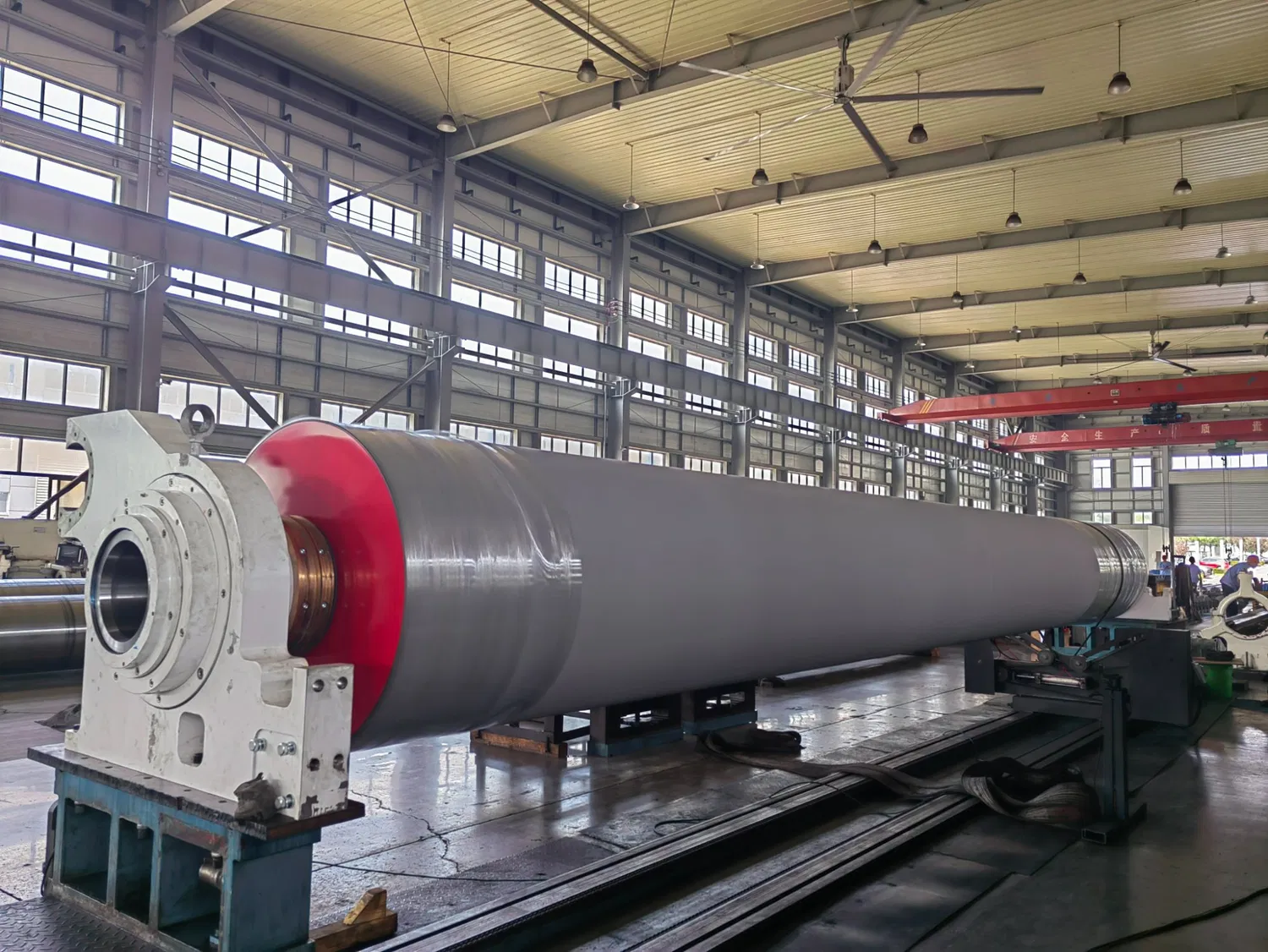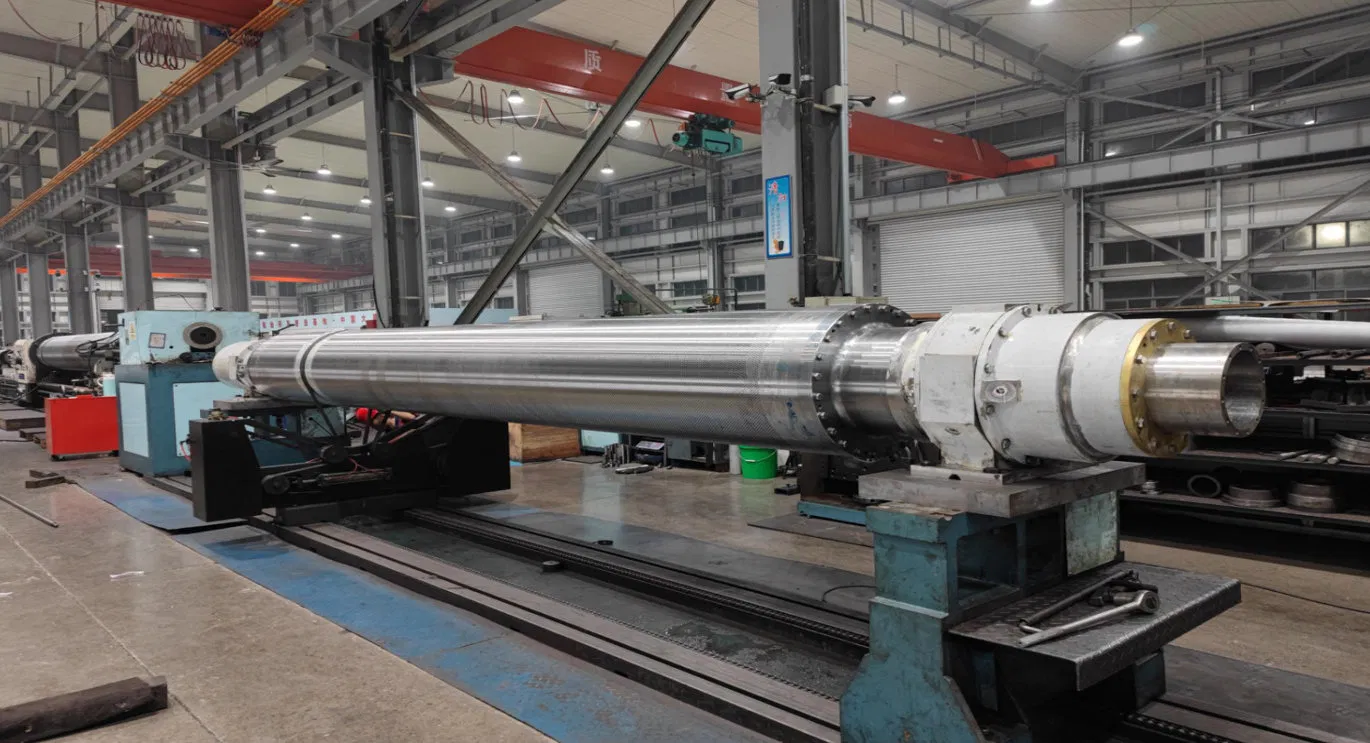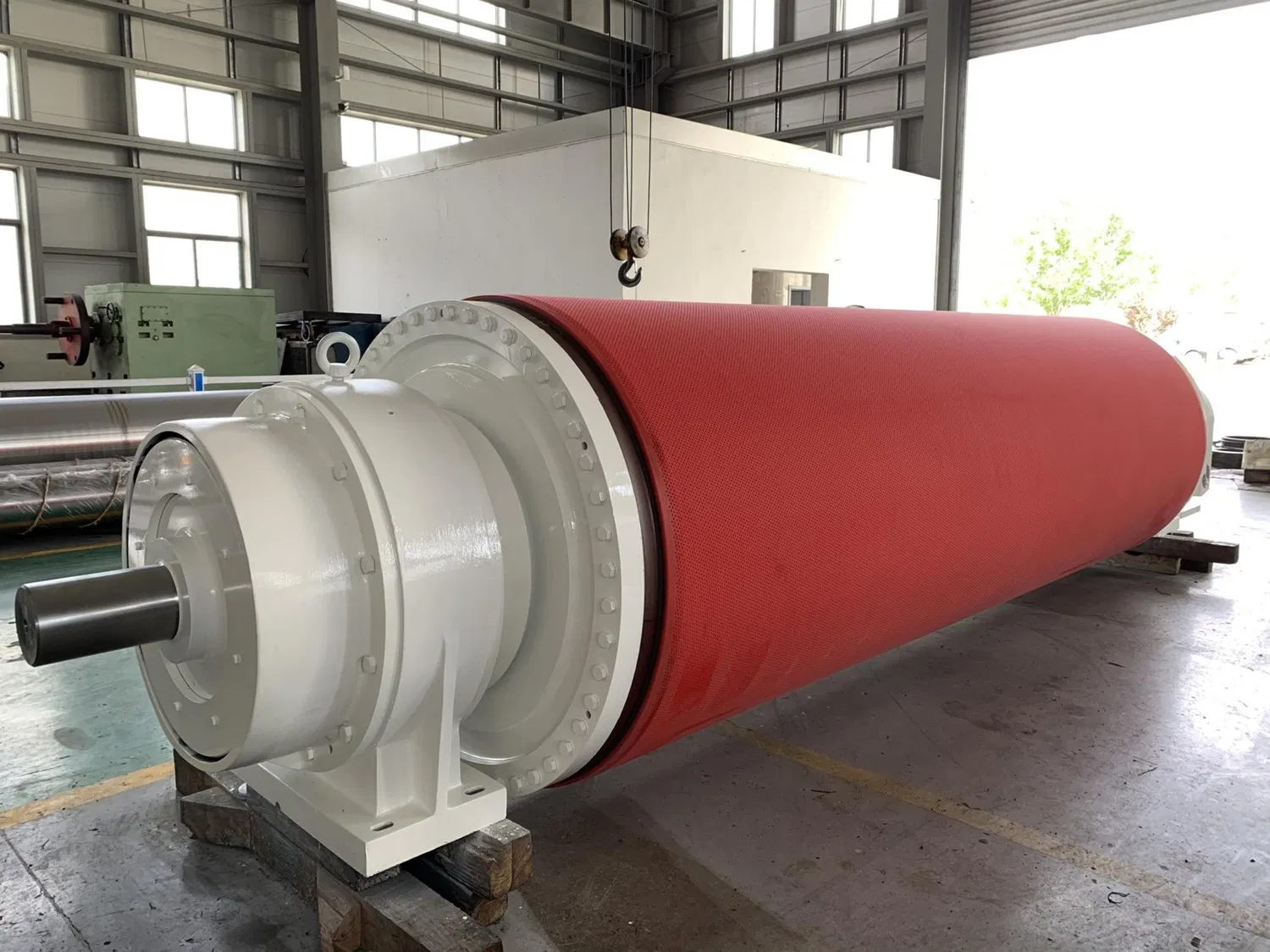The Critical Role of Press Rolls in Paper Production
The press section of a paper machine is where the wet paper web, typically containing 80-85% water after the forming section, undergoes mechanical dewatering. This process involves passing the web through a series of nips formed by two rotating rolls, applying immense pressure. The goal is to squeeze out as much water as possible, increasing the dry content of the web to around 40-55% before it reaches the dryers. This mechanical removal is significantly more energy-efficient than evaporating water with heat in the dryer section. Beyond just water removal, press rolls profoundly influence a range of paper properties. The pressure, temperature, and surface characteristics of the rolls affect the paper's density, smoothness, strength, bulk, and even its porosity. For instance, a harder nip can lead to a denser, smoother sheet, while a softer nip might preserve bulk. The type of press roll, its cover material, and its design directly impact the dewatering efficiency, the sheet's final properties, and the overall runnability of the machine. Therefore, understanding how to select paper machine press rolls is not just about dewatering; it's about engineering the very characteristics of your final product and optimizing paper machine press section performance.Key Factors Influencing Press Roll Selection
Selecting the right press rolls is a multi-faceted decision, influenced by a complex interplay of operational, material, and economic factors. Frankly speaking, there's no one-size-fits-all solution. Each mill, each paper grade, and each machine has unique requirements.1. Roll Material and Cover Type: The Foundation of Performance
The core material and, more importantly, the cover material of a press roll are fundamental to its performance and longevity. * Core Materials: Traditionally, cast iron and steel have been common. However, advancements have introduced composite materials, which offer benefits like lighter weight, improved corrosion resistance, and sometimes better dynamic stability at high speeds. * Cover Materials: This is where much of the magic happens. Roll covers are typically made from rubber, polyurethane, or specialized composite materials. * Rubber Covers: Offer good elasticity and conformability, which helps in achieving a uniform nip pressure. They come in various hardnesses (measured in P&J or Shore D), with softer covers generally providing a wider nip and better dewatering for certain grades, while harder covers offer better sheet consolidation and wear resistance. * Polyurethane Covers: Known for superior wear resistance, chemical resistance, and stability at higher temperatures and speeds. They often provide excellent dewatering and longer run times between regrinds. * Ceramic and Hybrid Covers: These advanced covers offer extreme wear resistance, excellent release properties, and can withstand aggressive chemical environments. They are often used in demanding positions or for specific paper grades requiring superior surface finish. When considering factors for press roll material selection, you must weigh properties like wear resistance, chemical compatibility with process additives, heat generation within the cover, dewatering efficiency, and the desired sheet properties. A cover that's too soft might wear quickly or generate excessive heat, while one that's too hard might lead to sheet crushing or poor dewatering.
2. Roll Design and Configuration: Optimizing the Nip
The physical design of the roll surface plays a crucial role in how water is removed and how the sheet is handled. * Plain Rolls: Solid, smooth surface. They rely solely on pressure to dewater and are often used in the first press nip or for specific sheet characteristics. * Grooved Rolls: Feature circumferential grooves on the surface. These grooves provide channels for water to escape from the nip, preventing rewetting of the sheet. They are highly effective for dewatering, especially at higher speeds. The groove pattern (width, depth, spacing) is critical and optimized for specific paper grades and machine speeds. * Blind-Drilled Rolls: Have a pattern of blind holes drilled into the cover. Similar to grooved rolls, these holes act as reservoirs for water, preventing rewetting. They are often used in positions where a smoother sheet surface is desired compared to grooved rolls. * Suction Rolls: These rolls have a perforated shell and an internal suction box that draws water out of the web as it passes over the roll. They are typically used in the first press nip to quickly remove a large volume of water and improve sheet strength for subsequent nips. The choice of design directly impacts the nip width, pressure profile, and the ability to prevent rewetting, all of which are vital for improving paper machine dewatering efficiency.3. Machine Speed and Production Capacity: Matching the Pace
The operating speed of your paper machine is a critical determinant. Higher speeds impose greater dynamic stresses on rolls, requiring materials and designs that can withstand these forces without deforming or vibrating excessively. Rolls for high-speed machines often feature lighter core materials, advanced cover compounds with higher dynamic stability, and precise balancing. The production capacity, measured in tons per day, also influences the required robustness and longevity of the rolls. A roll that performs adequately at 500 m/min might fail prematurely at 1200 m/min.4. Paper Grade and Furnish Type: Tailoring to the Product
Different paper grades (e.g., newsprint, fine paper, board, tissue) have varying fiber compositions (furnish) and desired final properties. * Newsprint and LWC (Lightweight Coated): Often use high-speed grooved or blind-drilled rolls for maximum dewatering. * Fine Paper and Board: May require smoother plain rolls or specific cover hardnesses to achieve desired surface smoothness and density. * Tissue: Often uses specialized press configurations (e.g., shoe presses) and softer covers to maintain bulk and softness. * Recycled Fiber: Can be more abrasive and may require more wear-resistant roll covers compared to virgin pulp. The furnish type (e.g., hardwood, softwood, recycled, mechanical pulp) influences the web's compressibility and water retention characteristics, directly impacting the optimal press roll configuration.5. Operating Environment and Chemical Compatibility: Battling the Elements
The chemical environment within the paper machine, including pH levels, process additives, and temperature, can significantly affect roll cover integrity. Some chemicals can cause swelling, hardening, or accelerated degradation of certain cover materials. It's crucial to select covers that are chemically resistant to the specific conditions in your mill to prevent premature failure and ensure consistent performance. Corrosion resistance of the core material is also a concern, especially in acidic or alkaline environments.6. Energy Efficiency and Maintenance Considerations: The Long-Term View
While initial purchase cost is a factor, the total cost of ownership (TCO) is far more important. This includes: * Dewatering Efficiency: As mentioned, better dewatering in the press section directly reduces energy consumption in the dryer section, leading to substantial operational savings. * Roll Lifespan and Regrind Cycles: A durable roll cover that maintains its properties for longer periods reduces downtime for roll changes and the frequency of costly regrinds. * Ease of Maintenance: Some roll designs or cover materials are easier to clean or repair, contributing to lower maintenance costs. * Runnability: Rolls that contribute to stable machine operation, fewer breaks, and consistent sheet quality ultimately lead to higher productivity and lower overall costs.Advanced Considerations and Emerging Technologies
The world of paper machine press rolls isn't static. Innovations are constantly emerging, offering new ways to enhance performance and efficiency.1. Smart Rolls and Sensor Integration: The Future of Monitoring
Interestingly enough, the concept of "smart manufacturing" is extending to press rolls. Modern rolls can be equipped with embedded sensors that monitor critical parameters like temperature, pressure profiles within the nip, vibration, and even cover wear in real-time. This data can be fed into predictive maintenance systems, allowing mills to anticipate issues before they lead to costly downtime. This proactive approach to maintenance is a game-changer for optimizing paper machine press section operations.2. Composite Materials and Lightweight Designs: Pushing Boundaries
Beyond traditional metals, advanced composite materials are being used for roll shells. These materials offer several advantages: * Reduced Weight: Lighter rolls mean less inertia, which can lead to lower energy consumption, faster acceleration/deceleration, and reduced load on bearings. * Improved Dynamic Stability: Lighter, stiffer composites can perform better at very high speeds, minimizing vibration and improving nip consistency. * Corrosion Resistance: Composites are inherently resistant to many chemicals found in paper machine environments, extending roll life.3. Surface Technologies and Coatings: Enhancing Performance
Specialized surface treatments and coatings are continually being developed to improve specific roll characteristics. These can include: * Enhanced Release Properties: Coatings that prevent sticking of the paper web to the roll surface, reducing breaks and improving runnability. * Superior Wear Resistance: Ultra-hard coatings that extend the life of the roll cover, especially in abrasive environments. * Optimized Dewatering Surfaces: Micro-textured or specially engineered surfaces that promote faster water removal and prevent rewetting.
The Selection Process: A Step-by-Step Approach
Knowing the factors is one thing; putting them into practice is another. Here’s a practical approach to how to select paper machine press rolls:1. Define Your Goals: What Are You Trying to Achieve?
Before looking at any specific roll, clearly articulate your objectives. Are you aiming for: * Increased dry content out of the press? * Improved sheet quality (e.g., smoothness, strength, bulk)? * Reduced energy consumption in the dryer section? * Longer roll life and reduced maintenance? * Higher machine speed or production capacity? Your goals will dictate the priorities during the selection process.2. Assess Current Performance: Identify Bottlenecks
Conduct a thorough audit of your existing press section. * What is the current dry content after each press nip? * Are there any recurring issues like sheet breaks, barring, or excessive vibration? * What are the current roll change frequencies and regrind intervals? * Analyze energy consumption data for the dryer section. * Review maintenance logs for common roll-related problems. This assessment provides a baseline and highlights areas for improvement.3. Consult Experts and Suppliers: Leverage Knowledge
This is where collaboration becomes key. Engage with reputable press roll manufacturers and paper machine suppliers. Share your goals and current performance data. They possess a wealth of knowledge regarding different materials, designs, and their suitability for various applications. Discuss the specific factors for press roll material selection with them, providing details about your paper grades, furnish, machine speed, and operational environment. I've found that a collaborative approach with suppliers yields the best results, as they often have case studies and simulation tools to help predict performance.4. Evaluate Total Cost of Ownership (TCO): Beyond the Purchase Price
It's worth noting that while initial cost is a factor, the long-term TCO is far more critical. A cheaper roll that wears out quickly, causes frequent breaks, or leads to higher drying energy costs will be significantly more expensive in the long run. Consider: * Initial purchase price * Expected lifespan and regrind frequency * Impact on energy consumption (drying section) * Impact on machine uptime (reduced breaks, fewer roll changes) * Maintenance costs (cleaning, regrinding, repairs) * Impact on paper quality and potential for higher sales value5. Pilot Testing and Monitoring: Prove It Before You Commit
If feasible, especially for significant upgrades or new technologies, consider pilot testing. Many suppliers can offer trial periods or smaller-scale tests. Once a new roll is installed, rigorous monitoring is essential. Track key performance indicators (KPIs) such as: * Dry content before and after the press section * Energy consumption in the dryer section * Roll surface temperature * Vibration levels * Sheet quality parameters * Roll wear and regrind intervals Continuous monitoring and data analysis are crucial for validating your selection and ensuring that the new rolls are indeed improving paper machine dewatering efficiency and meeting your objectives.
For more detailed information, please visit our official website:Paper machine press rolls
About the author: Dr. Evelyn Reed is a seasoned paper manufacturing consultant with over two decades of experience in process optimization and equipment selection. Specializing in the press section, her expertise lies in maximizing dewatering efficiency and enhancing paper quality through strategic roll design and material science. Evelyn is passionate about sustainable papermaking and regularly advises mills worldwide on achieving peak operational performance and energy savings.


